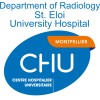
Fluoroscopy Versus Ultrasound Guidance for Sacral Lateral Branch Radiofrequency Ablation
Sacroiliac Joint ArthritisBack PainSacroiliac joint is a diarthroidal and synovial joint that receives sensory innervatin by the sacral lateral branches ( commonly S1-3, with variable contributions from L5 dorsal ramus and S4 lateral branch). Sacral lateral branch radiofrequency ablation and block techniques are widely used for the management of sacroiliac joint pain. With the increasing use of ultrasound technology in pain medicine, the ultrasound guided approaches gained popularity. To our knowledge, there are no randomized controlled trials comparing the ultrasound and fluoroscopy approaches for sacral lateral branch radiofrequency ablation. This study aims to compare the ultrasound and fluoroscopy guidance techniques for sacral lateral branch radiofrequency ablation.

Physiotherapy-led Outpatient Clinic for Patients With Spondyloarthritis
SpondylarthritisSpondylitis5 moreThe purpose of this study is to determine whether patients with spondyloarthritis are more satisfied with a physiotherapy-led outpatient clinic than usual care and whether there is a difference between patients in a physiotherapy-led outpatient clinic and those in usual care regarding disease activity, function and mobility.

Frequency of Sacroiliitis in Inflammatory Bowel Disease Patients Using MRI
Sacroiliitisto determine the overall frequency of Inflammatory sacroiliitis among patients with Inflammatory bowel disease using magnetic resonance imaging identify the association of sacroliitis in IBD patients clinical and laboratory markers

Intraartecular Platelet Rich Plasma for Sacroiliitis
SacroiliitisComparison between the effect of steroids and platelet-rich plasma on low back pain after ultrasound-guided sacroiliac injection to determine any is more effective and of long duration

Imaging for SIJ Injection Therapy
SacroiliitisSacroiliac Joint PainThe Research question: Among two standard image guidance techniques [2-dimension (2-D) conventional Fluoroscopy Versus 3-dimension (3-D) Cone-Beam Computed Tomography (CBCT)], which is the better guidance for Sacroiliac Joint Injection therapy and should be used first? The specific aims: To detect the difference of the first-time success rate, the cross-over rate, the procedural time, the radiation exposure, the incidence of adverse events/complications, and overall satisfaction score between the 2-D Fluoroscopy versus 3-D CBCT guidance for SIJ injection.

Cooled RF Lesion MRI Characteristics
Arthritis;LumbosacralOsteo Arthritis Knee4 moreThis Prospective, Single-center, Pilot Study will assist in gaining an understanding of the actual CRFA lesions in an in vivo situation in areas where CRFA is utilized as a standard of care treatment option for the relief of chronic pain (cervical facet joints, thoracic facet joints, lumbar facet joints, Sacroiliac (SI) region, hip and knee).

Sacroiliac Joint Fusion With iFuse Implant System (SIFI)
Degenerative SacroiliitisSacroiliac Joint DisruptionThe purpose of this study is to evaluate the use of the iFuse Implant System to treat degenerative sacroiliitis (arthritis of the SI joint) and sacroiliac disruption (abnormal separation or tearing of the sacroiliac joint). The iFuse Implant System (iFuse device) is a medical device that is surgically implanted into the sacroiliac (SI) joint during a minimally invasive surgical procedure (one that uses a smaller incision and less damage to the skin and other tissues than standard surgery). The purpose of implanting the device is to stabilize and fuse the SI joint.

Value of Tomosynthesis for the Detection of Sacro-iliitis (TOMOS SI)
SacroiliitisSpondyloarthropathies (SpAs) are chronic inflammatory diseases encompassing ankylosing spondylitis, psoriatic arthritis, reactive arthritis, enteropathic arthropathy, and undifferentiated SpA. In 2001, the estimated prevalence of SpA was 1.5% worldwide. Sacroiliitis is a condition caused by inflammation within the sacroiliac joint. It is the most frequent damage of SpA depicted at imaging evaluation. Conventional radiography (X-ray) is usually used to depict the structural changes associated with sacroiliitis. However further evaluation often requires additionnal computed tomography (CT). Tomosynthesis is an Xray-based imaging technology which allows reconstruction of multiple section images from a set of projection images acquired as the x-ray tube moves along a prescribed path. The advantagee of tomosynthesis is the significant reduction of radiation dose exposure compared to CT Tomosynthesis is currently used in the field of breast imaging and pneumology. Very few studies have examined the value of tomosynthesis for osteoarticular imaging. The study aims at evaluating the diagnostic performances of tomosynthesis as compared to standard X-ray and CT, in patients with a clinical suspicion of sacroiliitis. the investigators hypothesize that tomosynthesis is superior to conventional radiography for detection of sacroiliitis and is at least equal to CT with lower irradiation.

CT Follow-Up of the SImmetry Sacroiliac Joint Fusion System
SacroiliitisThis study will evaluate long-term follow-up of subjects implanted with the SImmetry Sacroiliac (SI) Joint Fusion System (SImmetry).

Sacroiliitis in Systemic Sclerosis
Systemic SclerosisSacroiliitis1 moreOne of the major problems of systemic sclerosis (SSc) patients is suggested to be articular involvement. Mostly involved joints in SSc were reported as wrist, carpometacarpal-interphalangeal, foot, knee, hip and shoulder however there have been little knowledge on sacroiliac joint. Here the investigators plan a study on the involvement of this joint in SSc.
